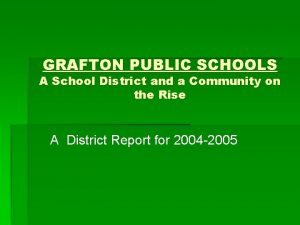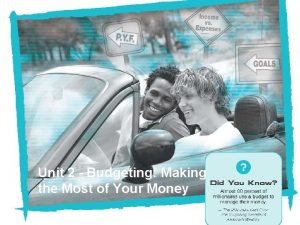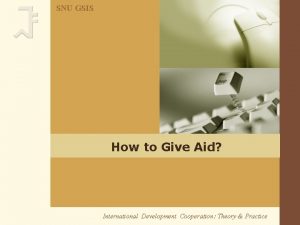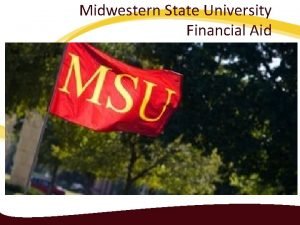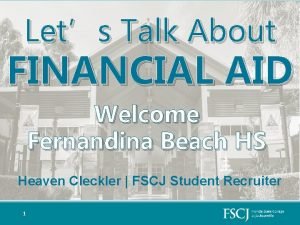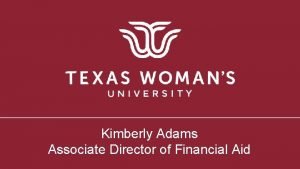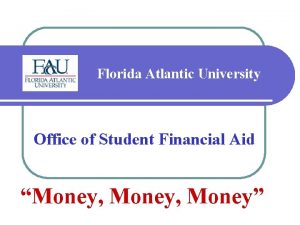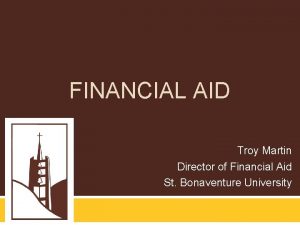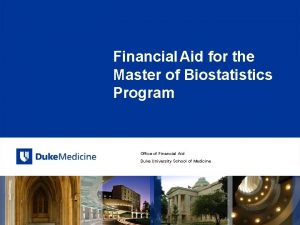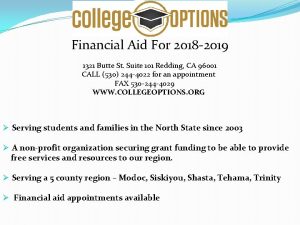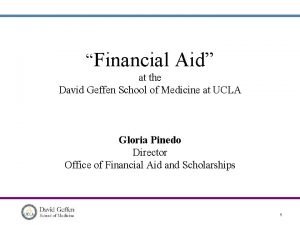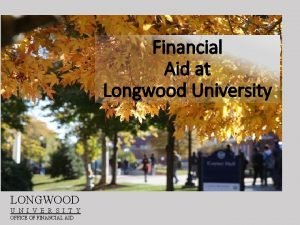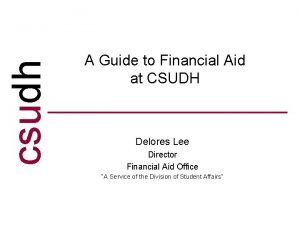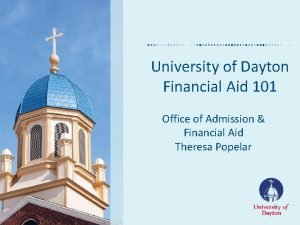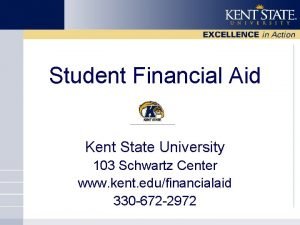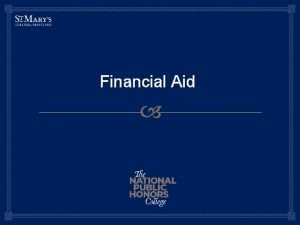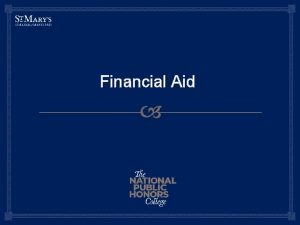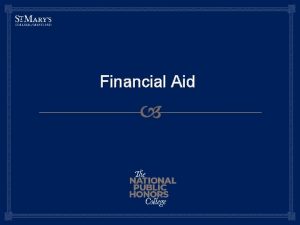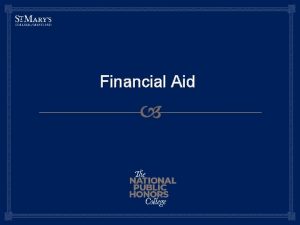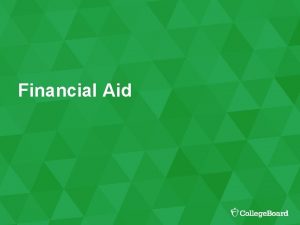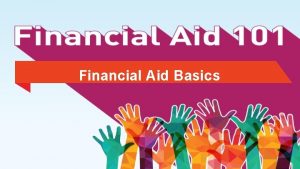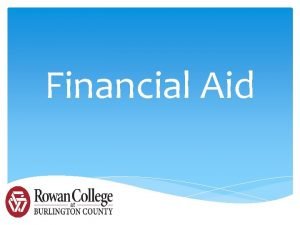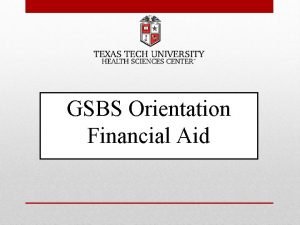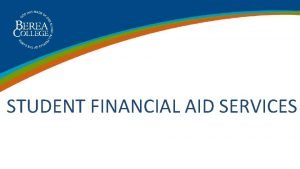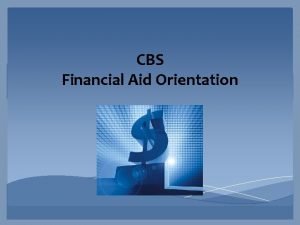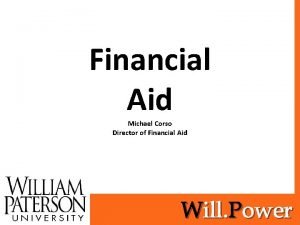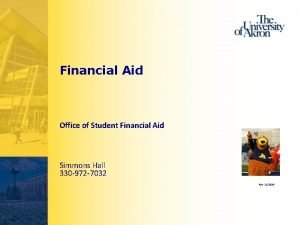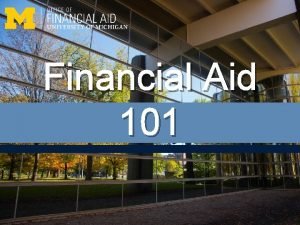Understanding Financial Aid Grafton High School Margaret Zitzer




























- Slides: 28

Understanding Financial Aid Grafton High School Margaret Zitzer December 12, 2011

Agenda o Principles of Financial Aid o Key Concepts o Completing the FAFSA o Types of Aid Available

Basic Principles of Financial Aid • Parents have primary responsibility to pay for the education of their dependent children. • Students also have a responsibility to help pay for their educational costs. • A family’s ability to pay for educational expenses must be evaluated in an equitable and consistent manner while recognizing that special circumstances can and do alter a family’s ability to pay.

Financial aid helps bridge the gap between the cost of education and what the family can pay.

Key Concepts o Cost of Attendance (COA) o Expected Family Contribution (EFC) o Demonstrated Financial Need (Need)

Cost of Attendance o o o Tuition (Direct & Indirect Costs) Fees Room & Board Books & Supplies Personal/Miscellaneous o Travel

Expected Family Contribution (EFC) Determined by filing the FAFSA Free Application for Federal Student Aid

EFC o Income o Assets o Family size o Number in College o Age of the older parent

Demonstrated Financial Need is a simple equation: COA -EFC =Need

Examples of Financial Need Public College Private College Cost $21, 447 EFC -$10, 000 Need $11, 447 Cost $42, 224 EFC -$10, 000 Need $32, 224 Source: The College Board Average College Costs, 2011 -2012

Get Organized o To complete the FAFSA you will need to: o Gather your and your parent’s 2011 tax information o Apply for a Personal Identification Number (PIN) o Parent must have his/her own PIN. o PIN serves as electronic signatures for the FAFSA and promissory notes www. pin. ed. gov


Submit the FAFSA www. FAFSA. gov o Select the appropriate school year o Complete all sections about you, your school plans and the financial information o List your school code(s) o Provide electronic signatures (PINs) o Submit your information o Keep copies for your records


Completing the FAFSA Points to Remember: o The earliest you may file the FAFSA for the 20122013 school year – January 1, 2012. o Check with the colleges where you plan to apply for deadlines and institutional requirements. o The FAFSA is student specific. o You do not need to wait until tax returns are filed; It is o. k. to estimate. o Must do the IRS Data Retrieval Process (with initial application or corrections) Available 7 -10 days after federal tax returns are filed o Who is considered a parent? o You must re-apply for aid every year.

FAFSA Follow up Here’s what happens after you file: o Your EFC is calculated o Results are sent electronically to the college(s) you selected. (You may list up to 10 schools on the electronic FAFSA) o You will receive a Student Aid Report (SAR). o If you have special circumstances notify the Financial Aid Office. (Extraordinary expenses and/or loss of income) o After you are admitted to a college, a financial aid award will be sent to you. o You may be required to verify information submitted on your FAFSA.

Types of Aid Available o Gift o Scholarships o Grants o Self-help o Employment o Loans

Scholarships Academic - merit based Talent Service ROTC Private www. fastweb. com www. Collegescholarships. org www. Broke. Scholar. com

Grants (Need-based) Federal Grants Pell SEOG TEACH State Grants WTG/WHEG Institutional Grants

Employment o Two types: o Federal Work Study o Regular Campus Employment o Can be used for personal expenses o Does not adversely affect grades

Student Loans Federal Stafford Subsidized Unsubsidized Federal Perkins* 5% interest rate interest deferred while in school (anyone can borrow) No loan fee Fixed interest rate of 6. 8% Freshmen - $3500 Sophomores - $4500 Juniors/Seniors - $5500 Additional Unsub $2000/year 9 month grace period 10 year repayment (Loan Fee of 1%) 6 month grace period 10 year repayment *Program set to expire 2014

Other Options o Parent PLUS Loan o Student Alternative Loans – Private Lenders o Private Scholarship o MUST be reported to the school o Payment Plan o Tax Credits o Ed. Vest (529 Plan) Withdrawals

Comparing Financial Aid Offers Step 1 Calculate your direct costs (tuition, room & boards and fees) $20, 000 Tuition + 3, 000 Room + 3, 000 Board + 500 Fees $26, 500 Direct Costs

Comparing Financial Aid Offers Step 2 Subtract any gift aid (grants and scholarships) $26, 500 Direct Costs -5, 550 Pell Grant - 2, 900 WI Grant - 10, 000 Institutional Grant $8, 050 Remainder After Gift Aid

Comparing Financial Aid Offers Step 3 The remainder after gift assistance will need to be covered by loans, employment or personal resources (i. e. cash, savings, payment plans and etc. ) $8, 050 Remainder After Gift Aid - 3, 500 Stafford Loan - 2, 000 Unsubsidized Stafford Loan $2, 550* Remainder to be covered by Parent Loan, Alternative Loan, Payment Plan or Personal Resources, etc * You MUST have a plan to cover your remaining Balance

Net Price Calculator • Early financial aid estimation tool • The average yearly price actually charged to full-time, first-year undergraduate students receiving student aid at an institution of higher education. • Estimate net price=COA – grants & scholarships

College Goal Sunday http: //www. wicollegegoalsunday. org/ • College Goal Sunday – “Weekend Edition” is a Statewide event that will offer free assistance to families in completing the FAFSA • February 18, 2012 and February 19, 2012 • Assistance with paper and online FAFSAs • Scheduled at 29 sites throughout Wisconsin

Additional Information Marquette University Office of Student Financial Aid (414) 288 -4000 marquettecentral@marquette. edu website: www. marquette. edu/mucentral
 Temple grafton school
Temple grafton school Grafton primary school website
Grafton primary school website Hsa grafton
Hsa grafton Solar shop grafton
Solar shop grafton Grafton county jail
Grafton county jail Grafton public schools
Grafton public schools First aid merit badge first aid kit
First aid merit badge first aid kit Neasden medical centre
Neasden medical centre High school financial planning program answer key
High school financial planning program answer key High school financial planning program answer key
High school financial planning program answer key Nefe high school financial planning program answers
Nefe high school financial planning program answers Nefe high school financial planning program answers
Nefe high school financial planning program answers Financial aid card
Financial aid card Selu financial aid
Selu financial aid Snu gsis
Snu gsis Financial aid midwestern state university
Financial aid midwestern state university Fscj financial aid office
Fscj financial aid office Twu financial aid office hours
Twu financial aid office hours Fau financial aid
Fau financial aid Troy financial aid
Troy financial aid Duke financial aid office
Duke financial aid office Butte financial aid
Butte financial aid Myucla bruinbill
Myucla bruinbill Longwood student accounts
Longwood student accounts Csudh fafsa
Csudh fafsa Baylor university financial aid
Baylor university financial aid Algonquin college financial aid
Algonquin college financial aid Dayton financial aid
Dayton financial aid Kent state cost of attendance
Kent state cost of attendance





